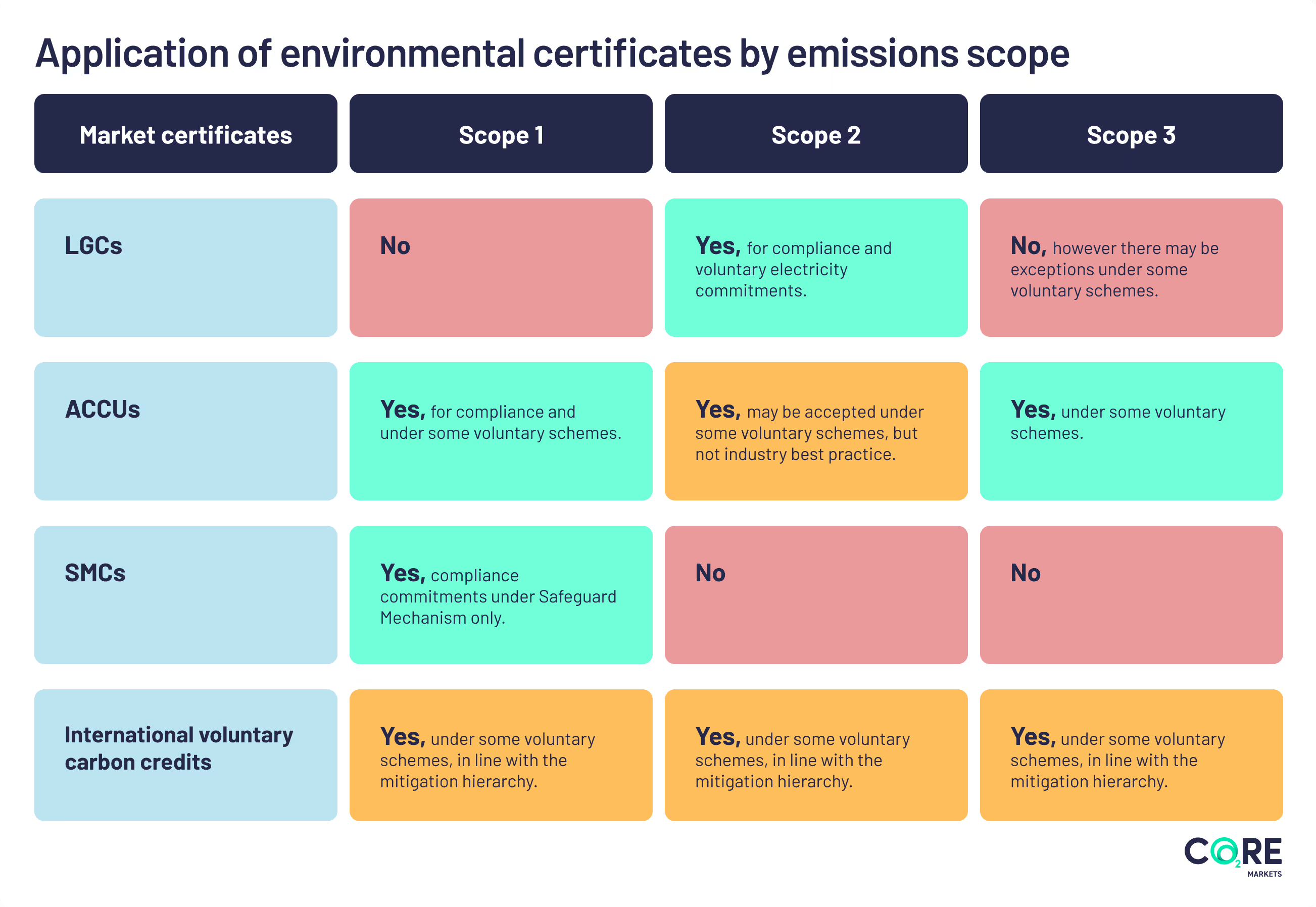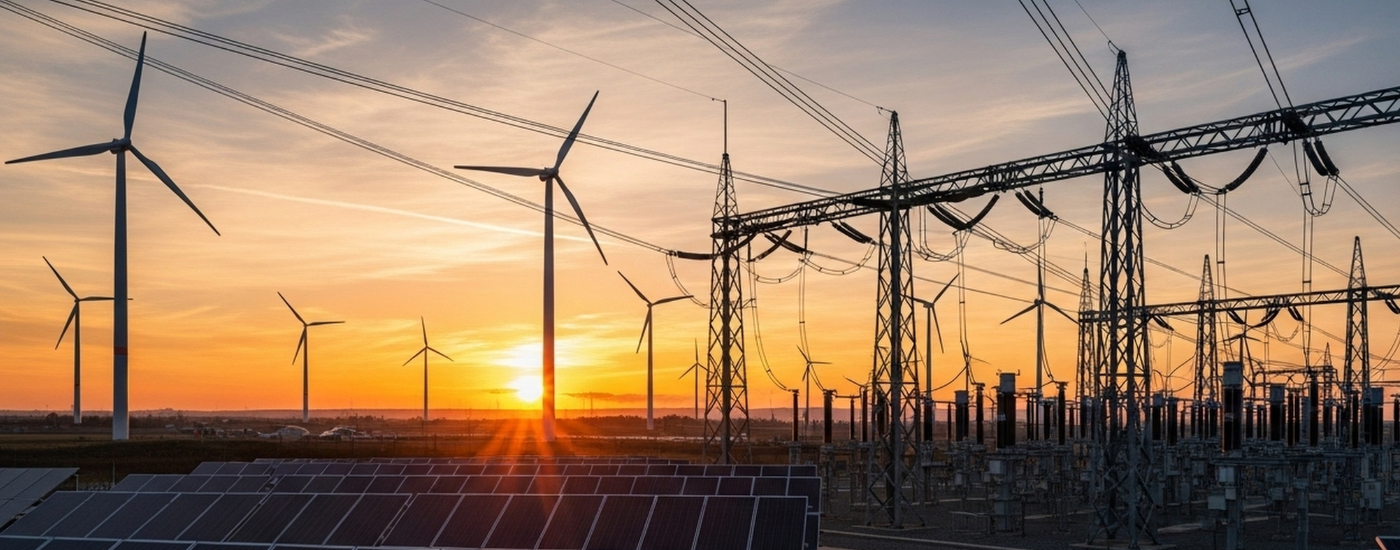Renewable energy and carbon markets are part of the corporate climate toolkit. They help internalise the cost of the renewable energy transition and the impact of an emissions footprint. Understanding the intricacies and developments between them is an essential part of the process.

Read time: 7 min
Corporate climate action has multiple activity streams, but they are not necessarily linear. While it must focus on physical emissions reduction, forward-looking organisations understand that, to meet their climate and commercial targets, they must plan for their residual emissions in parallel.
Renewable energy and carbon markets are part of the corporate climate toolkit. They help internalise the cost of the renewable energy transition and the impact of an emissions footprint.
Understanding the intricacies and developments between them is an essential part of the process.
In this article we explore how these markets intersect with corporate climate action, with examples from the Australian context.
Key insights include:
Renewable energy and carbon markets are important vehicles to help transition the world to a low carbon economy.
Renewable energy markets help fund the technology and infrastructure needed to transition to renewable energy sources. Carbon markets help nations, businesses and individuals to internalise the cost of their emissions and therefore funnel funding to essential emissions abatement projects.
Both types of markets are well established but also continuously evolving as the world aligns its efforts to meet our collective goal of Net Zero by 2050.
In the Australian context, the main renewable energy and carbon market units or certificates corporates must understand are:
We consider these in turn.
An LGC is a renewable energy certificate which represents renewable energy generated by large-scale renewable energy power plants such as solar or wind farms. Each LGC represents 1 megawatt-hour (MWh) of renewable energy generated.
LGCs are generated by government-approved projects and issued by the Clean Energy Regulator.
LGCs are one tool which energy retailers, who under Australia’s Renewable Energy Target (RET) scheme have regulated renewable energy targets, use to meet their targets. Other tools include direct investments in renewable energy projects.
Typically, LGCs are the ‘green currency’ of Power Purchase Agreements, where a renewable energy developer and buyer agree on a long-term contractual arrangement to purchase a set volume of renewable energy. LGCs may also be traded on the spot or futures markets.
LGCs can also be purchased by corporates to meet their voluntary renewable energy commitments.
Many voluntary standards, including the Science Basted Targets initiative (SBTi), recognise the use of renewable energy certificates as a Scope 2 emission mitigation method.
An ACCU is a carbon credit unit generated by government-approved projects and issued by the Clean Energy Regulator. Each unit represents one tonne of emissions avoided or removed from the atmosphere.
Under Australia’s Safeguard Mechanism scheme, the country’s biggest emitters must keep their direct Scope 1 emissions below government set, and continually reducing, baselines.
Those who emit more must purchase carbon credits, in the form of ACCUs or Safeguard Mechanism Credits.
While ACCUs and SMCs are both compliance units, ACCUs may also be used for voluntary emissions mitigation efforts by organisations not captured by the Safeguard Mechanism.
SMCs can be generated by Safeguard Mechanism entities that operate below their emissions baselines. Each SMC represents one tonne of emissions.
It is expected, however, that the trading of SMCs will be limited in the first few years, with SMCs generated likely to be held for future surrender periods. SMCs can only traded between Safeguard Mechanism entities.
Organisations captured by Australia’s emission reduction regulation and the Safeguard Mechanism must use ACCUs or SMCs to offset any residual emissions and meet their government-set baselines.
Australian organisations making voluntary commitments can explore ACCUs or other international carbon units such as Verra’s Verified Carbon Units (VCUs), or Gold Standard’s Certified Emissions Reduction (CER) or Voluntary Emissions Reduction (VER) units.
While these organisations have greater flexibility, their choice of units is still governed by the voluntary standard selected to guide their efforts. Each voluntary standard has its own specification for the credit and certificate types that can be used to meet its requirements.
Examples of voluntary standards include Australia’s Climate Active scheme or the international Voluntary Carbon Markets Integrity Initiative and its Claims Code of Practice.
The Science Based Targets initiative (SBTi) and its Corporate Net Zero Standard, while under review, does not currently endorse the use of carbon credits to offset emissions.

For many organisations, particularly large emitters, the process of emissions reduction can be long, costly and often limited by available technology.
The emissions footprint is broken down by emissions scopes:
Given the size of the challenge and the urgency of the global problem, many forward-looking organisations are addressing all emission scopes in parallel to the best of their current capability.
It may look like this:

While renewable energy and carbon markets are well established, they continue to evolve. At the same time, new environmental markets are emerging to support other critical transition priorities not enabled by existing market mechanics.
Renewable energy certificates, such as LGCs, are designed to help funnel investment into renewable energy infrastructure and, therefore, a ‘greener’ grid. Variations of this model around the world have supported the uptake of renewable energy seen to date.
However, this model relies on annual matching of certificates to the energy load of the buyer. As the renewable energy outputs and the energy demand are not matched in real time, there will be hours with under and over supply of renewable energy. During these times, the grid may be taking power from non-renewable sources. This is illustrated in the image below:

The next stage of grid decarbonisation relies more on where, when and what types of green power is deployed. Renewable energy certificates stamped with this information are referred to Granular Certificates (GCs).
Governments and organisations around the world are actively exploring this concept (under differing names and models). They include Google, Microsoft and the European and US governments.
Australia is planning to operationalise a Renewable Energy Guarantee of Origin (REGO) scheme as an update to the RET, in the second half of 2025. The scheme is still in consultation and one of the concepts being explored is optional granular matching.
While most schemes are still being developed, the expected benefits of Granular Certificate frameworks include:
We explore this in detail in our recent report
The global Paris Agreement is being translated into continuously tightening national regulations. Compliance carbon markets globally are evolving in line with these changing targets.
This directly impacts many large corporates while a growing number of smaller organisations, not yet captured by these regulations, are taking proactive voluntary action.
There are also ongoing efforts to continuously improve the integrity and trust in carbon credit units, both compliance and voluntary.
The ACCU scheme is managed by Australia’s Clean Energy Regulator and is globally recognised for its focus on carbon credit quality and, therefore, positive impact. The government continues to invest in framework improvements, with the implementation of recommendations from an independent scheme review (the Chubb Review) currently underway.
The process of continually tightening the quality criteria for all carbon schemes, including ACCUs, is welcomed by market participants. It helps to build trust and momentum in the market.
There are several initiatives underway to improve the integrity of the voluntary carbon market. The most noteworthy being the Integrity Council for the Voluntary Carbon Market (IC-VCM) Core Carbon Principles (CCPs) framework and associated label to help buyers identify high-quality carbon credit units.
Environmental markets are evolving beyond pricing a single unit of emissions through carbon markets or helping to fund the renewable energy transition through renewable energy markets.
We are seeing an emergence of new markets that help direct global investment towards high-impact, unscaled climate solutions.
Biodiversity loss, low-carbon fuels and granular renewable energy tracking are just a few examples of transition priorities shaping the next wave of environmental markets.
We explore this in detail in our recent report
Renewable energy and carbon markets – when used in line with the mitigation hierarchy – are an important part of the corporate climate toolkit.
While these environmental markets are well established, they are also continually evolving to offer new ways to help meet global Net Zero targets.
Forward-looking organisations are focused on emissions reduction and on understanding and leveraging market-based mechanisms to help them reach their climate and commercial goals. Get in touch to see how we can help.
The role of renewable energy and carbon markets in the corporate emissions reduction portfolio

As the NEM Review lands, attention rightly turns to system-level settings. But much of the commercial change shaping renewable and firming supply is already unfolding inside over-the-counter (OTC) energy markets. This article sets out what’s already shifting commercially in a market under review.

As the NEM Review lands, attention rightly turns to system-level settings. But much of the commercial change shaping renewable and firming supply is already unfolding inside over-the-counter (OTC) energy markets. This article sets out what’s already shifting commercially in a market under review.